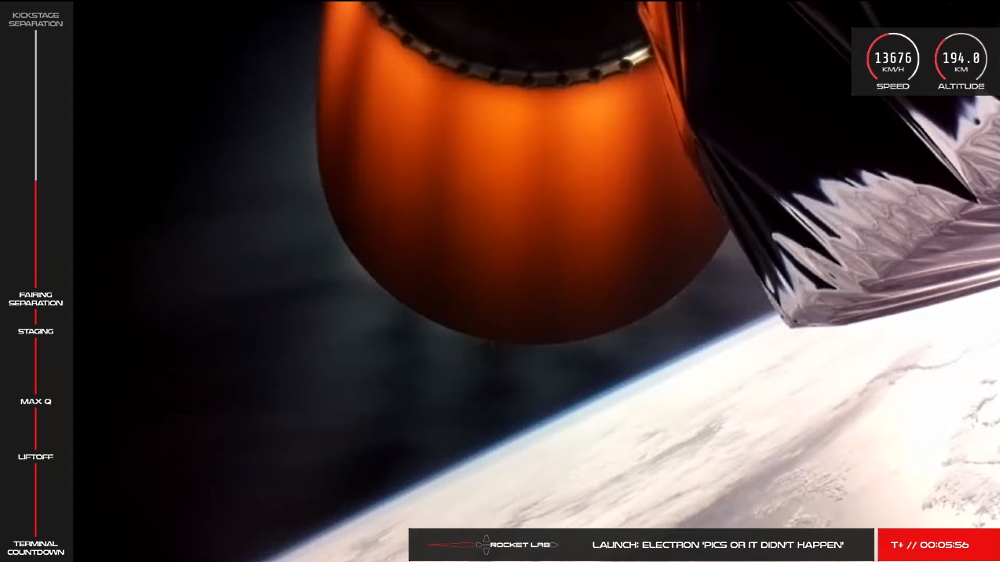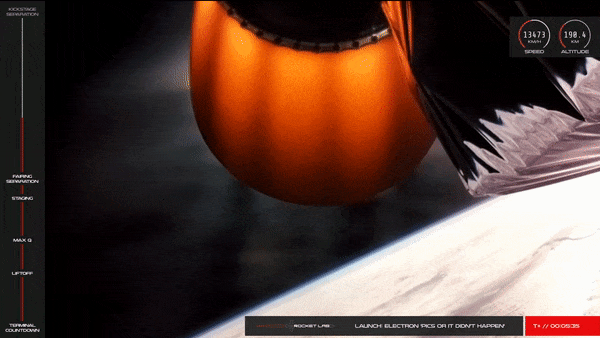
Broadcast still image from Rocket Lab
On July 4, at 21:19 UTC (09:19 local time), the Electron launch vehicle with seven satellites took off from the launch pad of the New Zealand cosmodrome on the Mahia Peninsula. For three hundred and forty-one seconds, the flight proceeded normally, but then the picture from the onboard cameras "froze".

Loss of telemetry is unpleasant, but not fatal. However, a few minutes later, the Rocket Lab company, which created the rocket, published a message about the loss of the carrier and payload. There is still no publicly available data other than the broadcast, and from it one can make a fairly reliable conclusion about what happened, but not why.
It may seem that telemetry disappeared along with the video, but this is not so. On the contrary, the numbers displayed in the upper right corner fit perfectly with a specific physical picture. If in the region of 341 seconds the thrust of the second stage engine disappeared, then, just, the altitude will rise for some time, but then it will begin to decrease - the rocket did not enter orbit. And the speed, at first slightly decreasing, then starts to grow when the step falls into the ocean. But why the engine thrust has disappeared, it is hardly possible to tell from the broadcast. The fact that the telemetry did not disappear at all says that some kind of power supply remained on board and there was no catastrophic destruction of the structure - the antennas remained connected to the transmitters, and the data continued to flow.There was another important stage in the operation of the stage - a hot switch to the third battery unit (they drive the pumps that supply fuel to the engine) and the discharge of two spent ones, but there was still almost a minute of flight before it (they are normally reset at 395 seconds), so this is unlikely to be related to the incident.
This is the second accident of the Electron booster. In the first test flight, on May 25, 2017, a tragicomic story happened - the flight of a serviceable rocket was abnormally terminated due to an incorrectly installed toggle switch on the ground telemetry receiving equipment.
So far, Rocket Lab has been doing well - in an address published shortly after the accident, the head, Peter Beck, stated that they " and the staff are ready for it. But the blow, of course, will have to withstand a strong one - 12 launches were planned for 2020. Rocket Lab achieved that the rocket was produced in 18 days, and the previous, 12 launch, took place on June 13, and after it only three weeks passed. Alas, this year Electron will no longer be able to become one of the most frequently launched rockets in the world - flights cannot be resumed until the problem is detected and fixed.

Dispenser payload, photo by Rocket Lab
With the rocket, the payload was lost - seven satellites with a total mass of about 75 kg. The largest and heaviest was the CE-SAT-IB (pictured above), Canon's second experimental Earth remote sensing satellite. The first device was launched in 2017 at the Indian PSLV, and now the company is developing serial satellites that are noticeably different in design, so the damage to the company is not fatal. Five Super Dove satellites were also remote sensing and belonged to the Flock 4e type from Planet Labs. This is a large and long-standing Rocket Lab client, which already has a constellation of dozens of deviceslaunched on different rockets. Precisely because six of the seven satellites were intended for photographing the Earth, the mission was named "Photos or not." The latest device, Faraday 1, was In-Space Missions' first experimental satellite to test the concept of providing a turnkey small satellite experiment deployment service. According to the company itself, they already have orders for four satellites, so let's hope they are not fatally hit.
Of course, it will be very interesting to find out the cause of the accident, we are waiting for the end of the investigation and publication of the results. Fortunately, Rocket Lab has already managed to prove the performance of its rocket with more than a dozen launches, and, despite a really unpleasant event, it can look into the future with optimism.